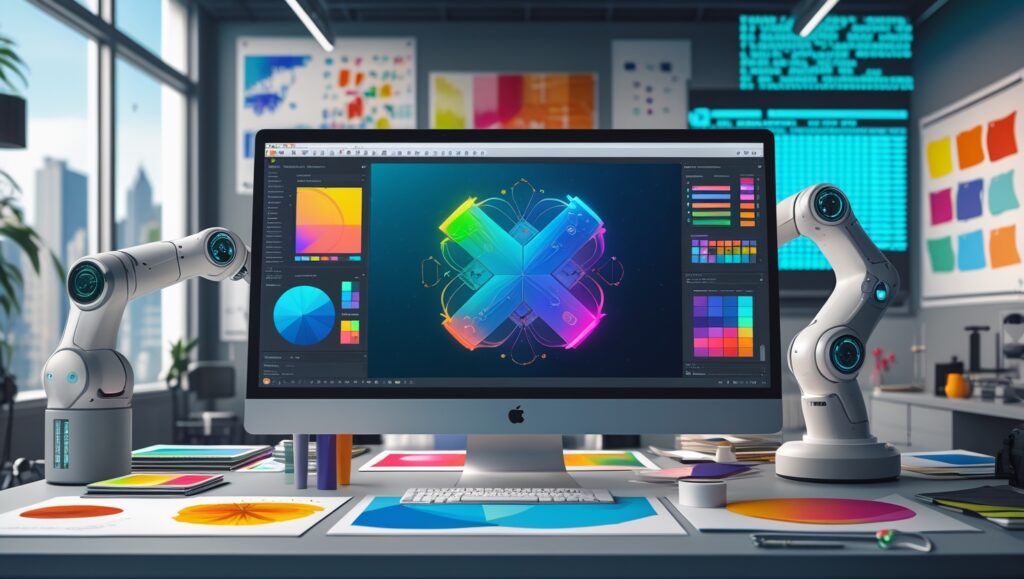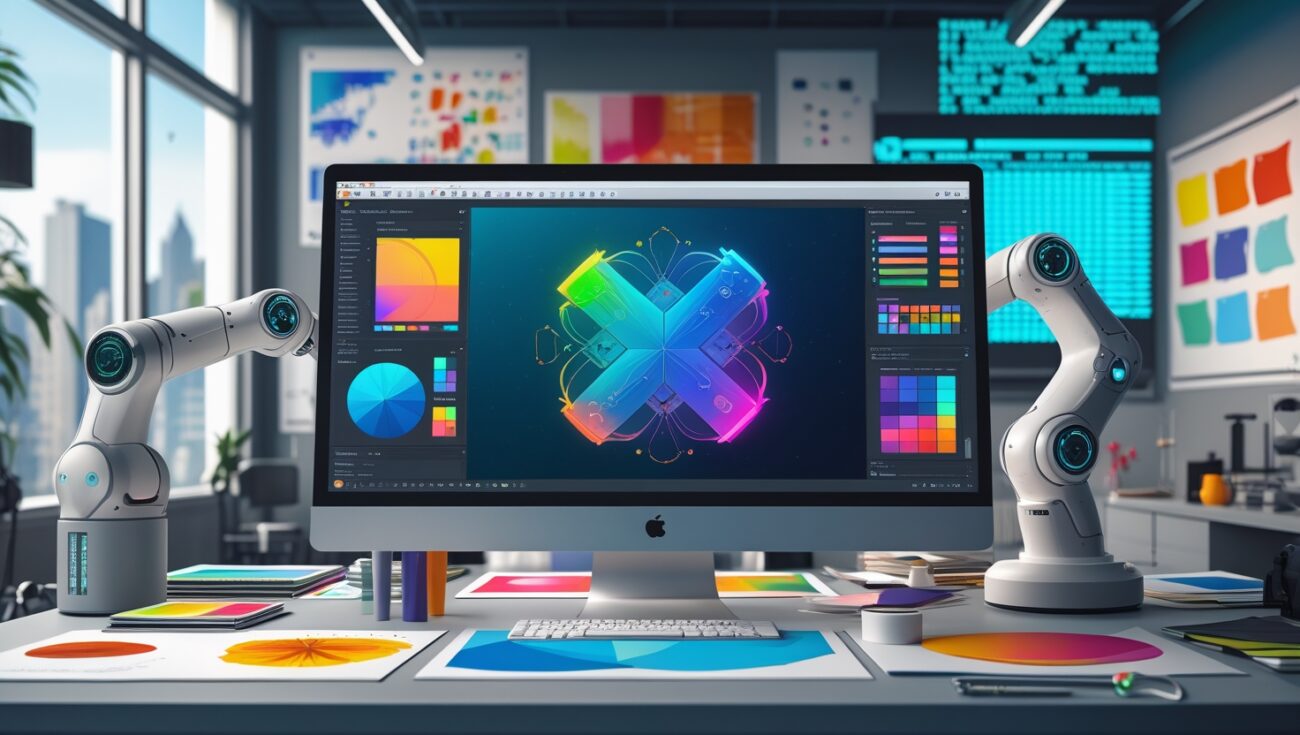How AI is Transforming the Graphic Design Industry
Artificial Intelligence (AI) is no longer just a buzzword—it has become a driving force behind the evolution of many industries. One of the most impacted fields is graphic design, where AI is transforming the way designers work, think, and create. From speeding up workflows to enabling non-designers to produce high-quality visuals, AI is reshaping creativity as we know it.
In this post, we’ll explore how AI is changing graphic design, the benefits and challenges it brings, and what the future looks like for designers in this AI-powered world. If you want to stay ahead of the curve, tools like Frase.io can help you leverage AI for content, design strategy, and improved efficiency.

Table of Contents
The Rise of AI in Creative Work
AI has entered the creative space with tools that can generate images, logos, layouts, and even animations in seconds. Platforms like MidJourney, Canva’s AI features, and DALL·E allow both professional designers and beginners to create visuals faster than ever. This doesn’t mean human creativity is being replaced—it means designers now have powerful assistants to speed up their process.
Automating Repetitive Design Tasks
One of the biggest advantages of AI in graphic design is automation. Instead of spending hours resizing images, cleaning up backgrounds, or adjusting layouts, AI can complete these tasks instantly. This allows designers to focus on the creative side of their work while leaving the repetitive tasks to AI-powered tools.
For example, Adobe’s Sensei AI can automatically detect objects in images, suggest design improvements, and optimize creative assets for different platforms.
Making Design Accessible to Everyone
In the past, high-quality design work required professional training and expensive software. Today, AI tools are making design accessible to business owners, marketers, and content creators who don’t have a design background.
Platforms like Canva and Figma now integrate AI to suggest templates, color schemes, and typography combinations—helping non-designers produce professional results. Combined with AI-powered research tools like Frase.io, even small businesses can create visually stunning and SEO-friendly content without hiring a full-time designer.
Personalized Design at Scale
AI makes it possible to design for personalization. Instead of creating one-size-fits-all graphics, AI can generate multiple variations tailored to different audiences. Brands can now deliver personalized marketing materials, ads, and visuals that resonate more deeply with their customers.
This level of customization would take weeks for a human designer, but with AI, it can be achieved in a fraction of the time.
Enhancing Creativity, Not Replacing It
A common fear is that AI will replace designers. In reality, AI is a tool that enhances human creativity. While AI can suggest patterns, generate layouts, or even create logos, it still requires a human touch for storytelling, brand strategy, and emotional impact.
Designers who embrace AI can push the boundaries of their creativity, using these tools to explore ideas faster and experiment with styles they might not have considered otherwise.
Faster Content and Design Integration
In today’s world, content and visuals go hand in hand. Whether it’s for blogs, ads, or social media, high-quality design is key to capturing attention. AI bridges the gap between content and design by helping creators generate both at the same time.
For example, a marketer can use Frase.io to generate SEO-optimized blog content while pairing it with AI-generated graphics for a complete publishing package. This creates a seamless workflow that saves time and boosts engagement.
Challenges of AI in Graphic Design
Of course, AI in design comes with challenges. Some of the most common include:
- Originality concerns – Since AI is trained on existing data, it can sometimes produce results too similar to existing works.
- Over-reliance – Designers who depend too much on AI may lose touch with fundamental design skills.
- Ethical issues – Questions about copyright and ownership of AI-generated visuals are still being debated.
Despite these challenges, the opportunities far outweigh the risks for those who use AI responsibly.
The Future of Graphic Design with AI
Looking ahead, AI will continue to evolve and integrate deeper into design workflows. We can expect more intuitive tools, smarter automation, and even real-time collaboration between AI and human designers.
The future isn’t about AI vs. humans—it’s about AI and humans working together to create more impactful, innovative, and scalable designs.
Final Thoughts
The graphic design industry is undergoing a massive transformation, and AI is at the center of it. By automating tasks, making design accessible, and enhancing creativity, AI empowers both professionals and non-designers to create at a new level.
If you’re a designer, marketer, or business owner, now is the time to embrace AI-powered tools. Whether you want to streamline content creation, improve SEO, or pair stunning visuals with engaging writing, platforms like Frase.io can give you the competitive edge you need.
AI-Driven Typography
Typography is essential in branding. AI tools now suggest font pairings that align with a brand’s tone, whether it’s professional, playful, or minimalist.
Color Psychology with AI
AI analyzes emotional responses to colors and recommends palettes proven to increase engagement. This means designers no longer rely solely on intuition but also on data.
AI in E-commerce Design
Online stores use AI to optimize product photos, enhance visuals, and even test multiple layouts to see which converts best.
Predictive Design Trends
AI forecasts design trends by analyzing millions of images online. This helps designers stay ahead of the curve.
Voice-Activated Design
Some platforms now let designers create visuals through voice commands, making design even faster.
AI for Accessibility
AI ensures designs are inclusive by suggesting color contrasts and layouts that are friendly for users with disabilities.
Sustainability in Design
AI reduces wasted resources by optimizing print layouts and predicting demand, lowering environmental impact.
Hyper-Personalized Marketing Assets
With AI, companies can create personalized graphics for each customer segment, boosting engagement rates.
Cross-Platform Consistency
AI helps maintain consistent branding across social media, websites, and advertising.
Real-Time Visual Adjustments
AI can adapt designs instantly based on user feedback, speeding up testing cycles.
AI-Powered Content Optimization
Using Frase.io, designers and marketers can optimize both visuals and written content for SEO, ensuring graphics align with search-driven strategies.
Freelancers Leveraging AI
Freelancers using AI deliver higher-quality projects in less time, giving them a competitive advantage in pricing and reputation.
Collaboration Between AI and Human Intuition
The best results happen when AI’s precision meets human emotion and storytelling — something machines cannot replicate.
Education and Skill Development
Design schools are beginning to teach AI-powered tools, preparing the next generation of creatives.
The Designer of Tomorrow
Tomorrow’s designer will be part creative, part technologist, and part strategist — mastering both AI and human imagination.

